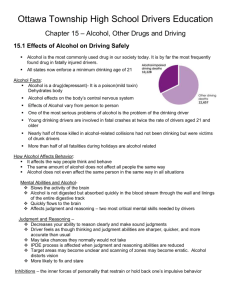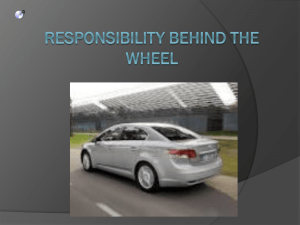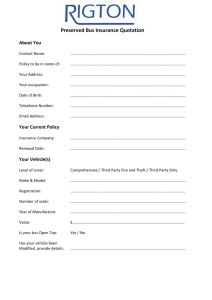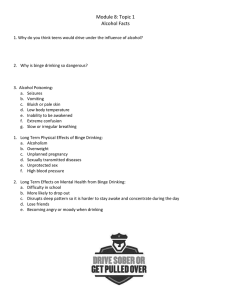Dangerous Driving Behaviors
advertisement
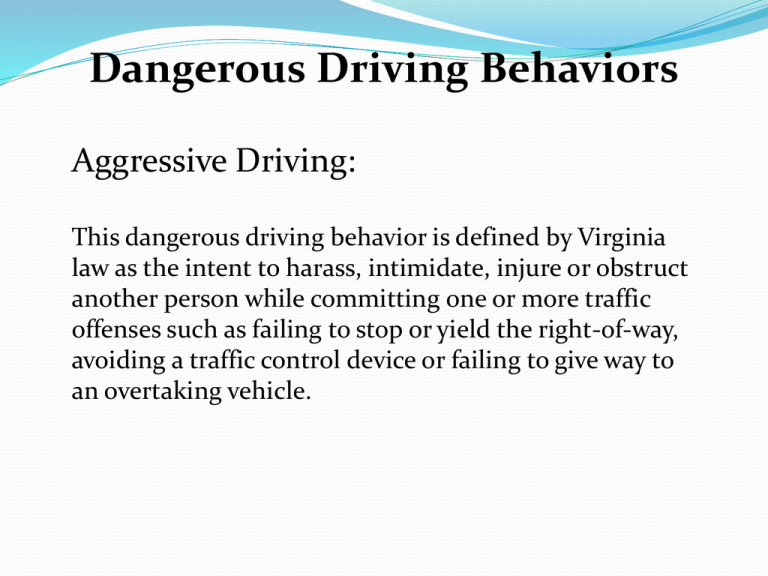
Dangerous Driving Behaviors Aggressive Driving: This dangerous driving behavior is defined by Virginia law as the intent to harass, intimidate, injure or obstruct another person while committing one or more traffic offenses such as failing to stop or yield the right-of-way, avoiding a traffic control device or failing to give way to an overtaking vehicle. When aggressive drivers are behind the wheel, these high-risk drivers take out their anger on other motorists. Their frustration levels run high while their concerns for fellow motorists runs low. They break the law by… running stop signs and red lights, speeding, tailgating, weaving in and out of traffic, passing on the right (including on the shoulder and unpaved portions of the road), making improper and unsafe lane changes, as well as making hand and facial gestures, screaming, honking and flashing their lights. Protect yourself. If you see an aggressive driver, stay out of the way. •Don’t challenge the aggressive driver by speeding up or trying to out-maneuver him. •Avoid eye contact and ignore his gestures •and shouting. Remember, if you are convicted of aggressive driving, your license could be suspended for ten days or for as long as six months. Distracted Driving Driving requires your full attention. There are many distractions that may prevent drivers from focusing on driving: changing the radio or CD, talking to passengers, observing outside surroundings, eating, using a cell phone and more. When on the road, drivers should not use cell phones, computers or other distracting devices except to report a crash or emergency. When engaging in distracting behavior, pull over and stop the vehicle in a safe location. Cell Phones Virginia law prohibits drivers under age 18 from using cell phones or any other wireless communication device while driving except in a driver emergency and the vehicle is lawfully parked or stopped. Text messaging or reading of text messages while driving is illegal for all drivers. Annually, driver distraction accounts for roughly 20 percent of all traffic crashes in Virginia. Why is distracted driving so deadly? While a driver is distracted, the vehicle may move into a high risk situation. The driver then loses precious seconds before recognizing the situation and must make an emergency maneuver. Young distracted drivers are even more susceptible. Failure to maintain proper control, following too closely, and not yielding the right-of-way are common actions of young distracted drivers. Inexperience in handling or controlling a vehicle during an emergency situation combined with distracted driving (cell phone use, other passengers, eyes not on the road, etc.) puts them at greater risk of a crash. Don’t let this happen to you. Take the following precautions. Concentrate. Keep your eyes on the road and your hands on the wheel at all times. Also, keep your body alert; sit straight, but relaxed. Look in the direction that you want to go. Set or adjust the controls on the vehicle and other devices as soon as you get in the car and before you begin driving. Do not use a cell phone. Anticipate the traffic and environment around you by searching ahead and checking your rearview mirrors often. Maintain a space cushion around your vehicle. Make sure there is enough room ahead of your vehicle and behind it. Drowsy Driving Constant yawning, head nodding, heavy eyelids, blurred vision and weaving while driving are some of the warning signs that you may be on the verge of falling asleep at the wheel. Driving while you are sleepy reduces your ability to drive effectively. Your reaction time is slower, awareness is decreased, and judgment is impaired. Often the actions of tired drivers are confused with drivers who had been drinking. The consequences can be just as fatal. To avoid falling asleep at the wheel: •Get plenty of quality sleep before a trip. •Avoid alcoholic beverages and heavy foods. •Beware of medications that can impair your driving ability. •Limit long distance driving. Stop at least every two hours for rest. •Stop at a safe place and take a nap. •If possible, drive with a companion and switch drivers when necessary. •Keep the temperature cool in your vehicle. Keep your eyes moving and check your mirrors often. •Avoid caffeine drinks. •If possible, avoid driving when drowsiness is most likely, from 10 PM to 6 AM. Drinking and Driving Legally, drivers age 21 or older are considered to be driving under the influence (DUI) if your blood alcohol content (BAC) is .08 percent or higher. If your driving is impaired, you can be convicted of driving under the influence with a BAC lower than .08 percent. If under age 21, you can be convicted of DUI if your BAC is .02 or higher. If your driving is impaired because you are under the influence of any drug, you may face the same penalties as driving under the influence of alcohol. Drinking and Driving Researchers estimate that between the hours of 10 PM and 2 AM three out of every ten drivers are drunk. More than one-third of these drivers have been drinking at someone else’s home. Nearly 50 percent of the drivers arrested for DUI are social to moderate drinkers. Don’t think that it won’t happen to you. In your lifetime, there’s a 50-50 chance that you’ll be involved in an alcohol-related crash. Just one… Just one alcoholic drink can affect your driving ability because even a small amount of alcohol affects the brain’s functions – particularly vision, judgment, and coordination. Because alcohol affects your judgment and driving ability, your chances of being in a crash are seven times greater if you drive after drinking than if you drive sober. Twelve ounces of beer is the same as a shot of liquor or a five-ounce glass of wine. Only time can decrease intoxication. Coffee, cold showers or exercise will not sober you up. Alcohol-related crashes are not accidents. They can be prevented! The only way to avoid the risks of drinking and driving is to decide before you start drinking that you are not going to drive. Remember, alcohol affects judgment. Making the decision not to drive is a lot more difficult after one or two drinks. Drive to social events in groups of two or more and have the driver agree not to drink. Combining alcohol with other drugs usually multiplies the effects of both and can have a disastrous effect on your ability to drive. One drink taken when you are on another drug – even an aspirin, or allergy or cold medicine – could have the same effect on your driving ability as drinking several alcoholic beverages. Topic 4 Lesson 4 Marijuana The active ingredient THC (delta-9tetrahydrocannabinol) impairs memory and learning perception (sight, sound, time, touch) problem-solving ability motor coordination tracking ability concentration T – 7.20 Topic 4 Lesson 4 Other Types of Drugs and Driving Prescription Medications • • • • • Tranquilizers Stimulants Narcotics Blood Pressure Insulin T – 7.21 Alcohol and the Law If you are arrested for drinking and driving, the penalties are severe. If the police have probable cause to stop you and suspect that you have been drinking or using drugs, they will ask you to take a breath or blood test. Under implied consent laws, if you operate a motor vehicle on Virginia’s public roads, you agree to take a test upon request. If you are involved in a motor vehicle crash and a law enforcement officer has probable cause, you can be arrested for DUI within three hours of the crash without a warrant and at any location. Administrative License Suspension If your BAC is .08 percent or higher while you are driving and law enforcement charges you with driving while under the influence of alcohol/drugs or refusing a breath test, your driving privilege will be automatically suspended: for seven days, for a first offense for 60 days or until you go to trial, whichever comes first, for a second offense until the trial, for a third DUI offense Open Alcohol Containers in Vehicles You may be charged with drinking while operating a motor vehicle if you: are stopped by law enforcement and you have an open container of alcohol in the passenger area and the contents have been partially removed, and show signs that you have been drinking **The passenger area means the area that seats the driver and passengers and any area within the driver’s reach, including an unlocked glove compartment. Transporting Children While Under the Influence of Alcohol/Drugs Conviction of any DUI offense involving a juvenile passenger (age 17 or younger) in the vehicle at the time of the offense carries an additional mandatory fiveday jail term plus all other fines and jail sentences. You may also be charged an additional fine of at least $500 and up to $1,000. A second DUI offense with a juvenile in the vehicle carries an additional 80-hour community service requirement plus all other fines and jail sentences. Vehicle Impoundment Your vehicle will be impounded immediately for 30 days if you are caught driving after your license has been suspended for an alcohol-related offense. The court can impound the vehicle for an additional 90 days if you are convicted. Alcohol Related Violations and Penalties Involving Persons Under Age 21 Purchasing/Consuming Alcohol: If you are under age 21, you cannot purchase, possess or consume alcohol. If you are convicted of driving after illegally consuming alcohol, and your BAC was at least .02 percent and less than .08, the court penalty will include: 1. 2. 3. a suspension of your driving privilege for one year from the date of conviction, and a minimum mandatory fine of $500, or the requirement that you complete at least 50 hours of community service. Providing Alcoholic Beverages: If you provide or sell alcoholic beverages to a person under age 21 or someone who is intoxicated or ordered by a court to refrain from drinking alcohol, you are subject to 1. 2. 3. a fine up to $2,500 mandatory suspension of your driver’s license for up to one year, and 12 months in jail. Misrepresentation of Age: If you are under age 21 and you use or attempt to use a fake ID to establish a false age in an attempt to drink or purchase alcohol, you will: be fined at least $500 be required to perform at least 50 hours of community service face up to 12 months in jail, and face mandatory suspension of your driver’s license for at least six months but not more than one year


